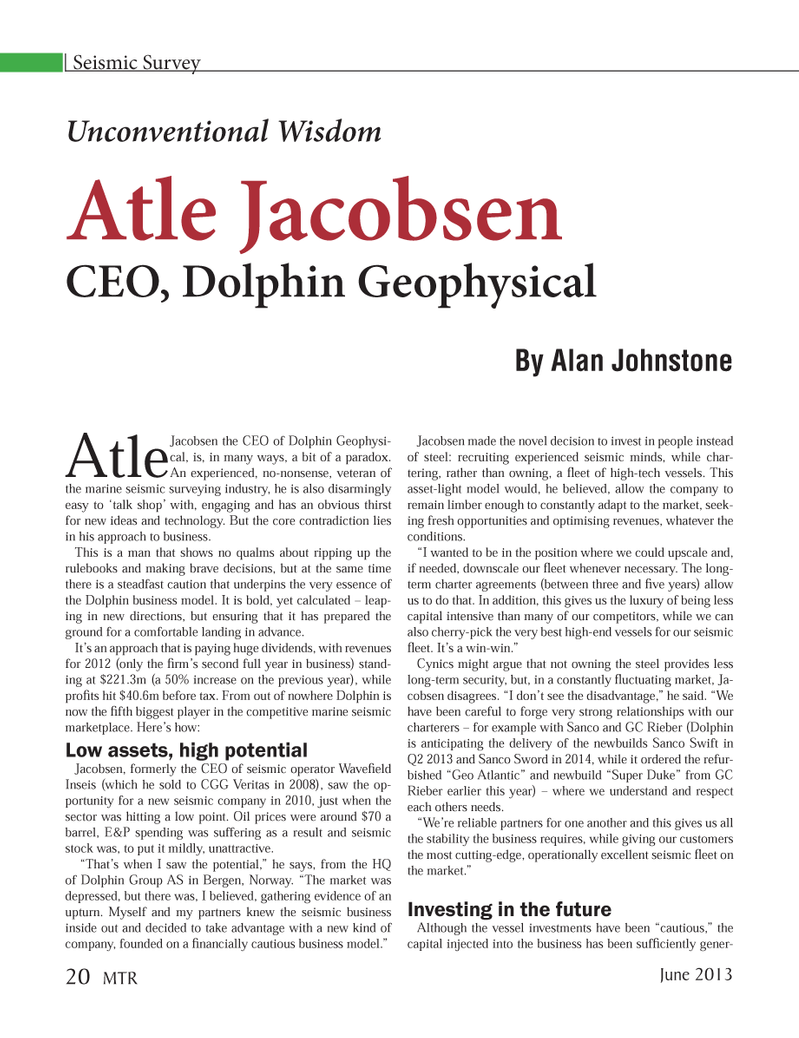
Page 20: of Marine Technology Magazine (June 2013)
AUV Operations
Read this page in Pdf, Flash or Html5 edition of June 2013 Marine Technology Magazine
Atle Jacobsen the CEO of Dolphin Geophysi-cal, is, in many ways, a bit of a paradox. An experienced, no-nonsense, veteran of the marine seismic surveying industry, he is also disarmingly easy to ?talk shop? with, engaging and has an obvious thirst for new ideas and technology. But the core contradiction lies in his approach to business. This is a man that shows no qualms about ripping up the rulebooks and making brave decisions, but at the same time there is a steadfast caution that underpins the very essence of the Dolphin business model. It is bold, yet calculated ? leap- ing in new directions, but ensuring that it has prepared the ground for a comfortable landing in advance. It?s an approach that is paying huge dividends, with revenues for 2012 (only the rm?s second full year in business) stand- ing at $221.3m (a 50% increase on the previous year), while pro ts hit $40.6m before tax. From out of nowhere Dolphin is now the fth biggest player in the competitive marine seismic marketplace. Here?s how: Low assets, high potential Jacobsen, formerly the CEO of seismic operator Wave eld Inseis (which he sold to CGG Veritas in 2008), saw the op- portunity for a new seismic company in 2010, just when the sector was hitting a low point. Oil prices were around $70 a barrel, E&P spending was suffering as a result and seismic stock was, to put it mildly, unattractive. ?That?s when I saw the potential,? he says, from the HQ of Dolphin Group AS in Bergen, Norway. ?The market was depressed, but there was, I believed, gathering evidence of an upturn. Myself and my partners knew the seismic business inside out and decided to take advantage with a new kind of company, founded on a nancially cautious business model.? Jacobsen made the novel decision to invest in people instead of steel: recruiting experienced seismic minds, while char- tering, rather than owning, a eet of high-tech vessels. This asset-light model would, he believed, allow the company to remain limber enough to constantly adapt to the market, seek- ing fresh opportunities and optimising revenues, whatever the conditions.?I wanted to be in the position where we could upscale and, if needed, downscale our eet whenever necessary. The long- term charter agreements (between three and ve years) allow us to do that. In addition, this gives us the luxury of being less capital intensive than many of our competitors, while we can also cherry-pick the very best high-end vessels for our seismic eet. It?s a win-win.? Cynics might argue that not owning the steel provides less long-term security, but, in a constantly uctuating market, Ja- cobsen disagrees. ?I don?t see the disadvantage,? he said. ?We have been careful to forge very strong relationships with our charterers ? for example with Sanco and GC Rieber (Dolphin is anticipating the delivery of the newbuilds Sanco Swift in Q2 2013 and Sanco Sword in 2014, while it ordered the refur- bished ?Geo Atlantic? and newbuild ?Super Duke? from GC Rieber earlier this year) ? where we understand and respect each others needs. ?We?re reliable partners for one another and this gives us all the stability the business requires, while giving our customers the most cutting-edge, operationally excellent seismic eet on the market.? Investing in the future Although the vessel investments have been ?cautious,? the capital injected into the business has been suf ciently gener- Unconventional Wisdom Atle Jacobsen CEO, Dolphin Geophysical By Alan JohnstoneSeismic Survey 20 MTRJune 2013MTR #5 (18-33).indd 20MTR #5 (18-33).indd 206/3/2013 1:01:02 PM6/3/2013 1:01:02 PM

 19
19

 21
21
